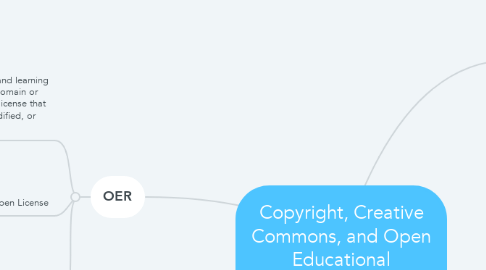
1. OER
1.1. Materials used for teaching and learning that are either in the public domain or have been released under a license that allows them to be used, modified, or shared with others.
1.1.1. Includes educational videos or even software to modify the material.
1.1.1.1. If copyrighted material is under a Non-Derivative License it would be illegal to modify the material.
1.2. Open License
1.2.1. Digital learning can strengthen a student's educational resources under the Every Student Succeeds Act.
1.2.1.1. Certain Foundations like the Nationals Science Foundation are required to have an open license for educational purposes.
1.2.1.2. This law has been delayed due to the Trump Administration rethinking most laws put into place under the Obama Administration.
1.3. Formal supplements used for an existing program or curriculum.
1.3.1. Teachers may use an open lesson online to create a practice used for students struggling with a certain concept associated with the topic they are learning about.
2. Copyright
2.1. Creator puts their name on something they have created so no one has the right to steal it for any purpose.
2.2. People would need permission to use pictures, videos, music, or anything else that somebody else created for any purpose.
2.3. Expires fifty to one hundred years after the creator dies.
2.4. Concept was developed in England with the invention of the printing press and the Licensing of the Press Act of 1662.
2.5. The Fair Use Doctrine is one of the laws of Copyright in the United States
2.5.1. An example of Fair Use would be any copying of copyrighted material done for a specific purpose like commenting, criticizing, or creating a parody of copyrighted material.
2.5.1.1. Parodies
2.5.1.1.1. People like to imitate copyrighted work in a comical way like how Weird Al made a parody of the song "Beat it" by Michael Jackson called "Eat it."
2.5.1.2. Commenting and Criticizing
2.5.1.2.1. People can comment and criticize copyrighted work because the public benefits from seeing things like reviews on hotels or items on Amazon.
3. Creative Commons
3.1. Others can use a creator's work without permission
3.2. Includes pictures, music, and videos
3.3. Rules include Attribution, Share-Alike, Non-Derivative and Non-Commercial
3.3.1. Attribution
3.3.1.1. A person must give credit to the creator but not in a way that suggests endorsing the creator unless they have permission to do so.
3.3.2. Share-Alike
3.3.2.1. A person can distribute, modify, copy, or perform a creator's work under the creator's terms
3.3.3. Non-Derivative
3.3.3.1. A creator's work can't be modified without permission from the creator. The original copy of the creator's work must be used.
3.3.4. Non-Commercial
3.3.4.1. A creator's work can't be used for commercial purposes unless a person has permission to do so from the creator.
